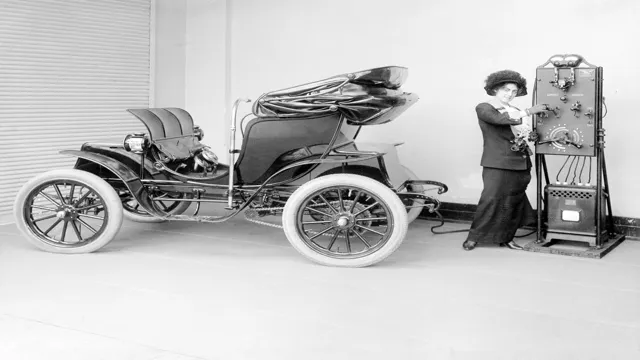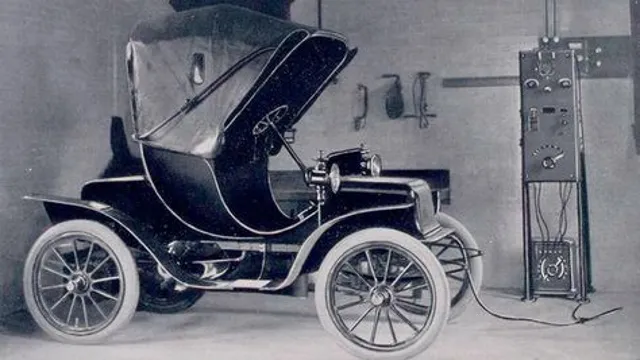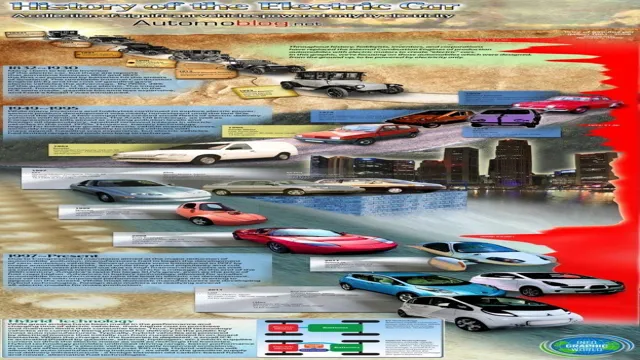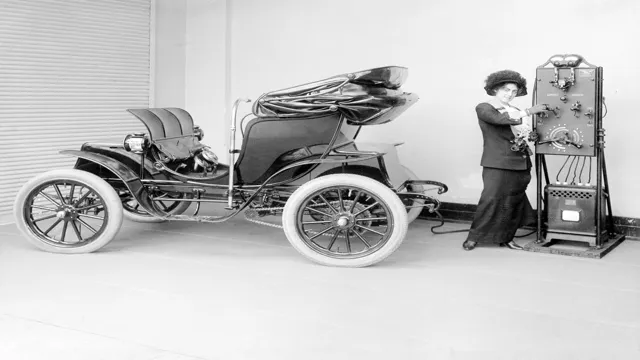The Electric Car Revolution: A Journey through History – Exploring the Evolution of Electric Vehicles
Electric cars have been growing in popularity in recent years, but their history stretches back much further than you may think. In fact, the first electric car dates back to the late 1800s when inventors around the world were experimenting with new technologies that could make transportation more efficient and environmentally friendly. Over the years, electric cars have seen a series of economic and technological challenges, which has, in turn, influenced their limited adoption rate.
But with the need for renewable and sustainable energy sources growing globally, these limitations are gradually being addressed. In this blog, we’ll take a deep dive into the history of electric cars, starting from their earliest beginnings and exploring how they’ve evolved into the modern, eco-friendly vehicles we see on the roads today. From the highly successful launch of the Tesla Model S to the emergence of more affordable electric cars from traditional brands like Chevrolet Volt, we’ll uncover the milestones in the history of electric cars and how they’ve influenced today’s manufacturing economy.
So, join me as we take a journey through the vehicle’s electrifying history and answer the question: What drove the development of electric cars, and how did they become what they are today?
Early Electric Vehicle Development
The history of electric cars dates back to the early 19th century. In fact, the first electric car was developed by Scottish inventor Robert Anderson in the 1830s. However, it wasn’t until the late 1800s and early 1900s when electric vehicles started to gain popularity.
During this time, a number of American inventors, including Thomas Davenport and Thomas Edison, developed their own versions of electric cars. But it was Henry Ford’s mass production of the gasoline-powered Model T in the early 1900s that led to the decline of the electric car. It wasn’t until the 1990s that electric cars began to make a comeback, thanks to advances in battery technology and growing concerns over air pollution and dependence on fossil fuels.
Today, electric cars are becoming more common, with major automakers developing their own models and governments around the world offering incentives to encourage their adoption.
Late 1800s to Early 1900s
During the late 1800s to early 1900s, the development of electric vehicles began to emerge as an alternative to gasoline-powered cars. Innovators such as Thomas Davenport and Robert Anderson played a significant role in creating the first electric cars in the 1830s. However, it wasn’t until the 1890s that electric cars gained popularity due to advancements in battery technology and the introduction of electric starter motors.
As a result, electric vehicles became a popular option for urban commuters because they were quiet, efficient, and produced no emissions. Despite their appeal, limited mileage and the expensive cost of battery replacements caused their popularity to diminish in the early 1900s. Nonetheless, the early development of electric vehicles was a pivotal moment in the evolution of the automobile industry.
Advancements and Limitations
Electric Vehicle Development is not a new concept. In fact, the concept dates back to the early 1800s when experiments were conducted on battery-operated vehicles. The first practical electric car was developed in 1884, and the early electric vehicle was characterized by its limited range, slow speed, and high production costs.
However, with time, technology has advanced, and new materials have been developed to increase the performance and efficiency of electric vehicles. One of the significant limitations of early electric vehicles was their range. They would often run out of power after traveling less than 100 miles.
This limitation has been addressed with the introduction of modern batteries that can travel over 300 miles before needing a recharge. Another limitation was the high production cost of electric vehicles, which has been overcome by mass production and improved manufacturing processes, leading to lower costs. The advancements in electric vehicle technology have also led to the development of hybrid and plug-in hybrid electric cars.
These cars combine the benefits of electric cars, such as low emissions and high efficiency, with the convenience of traditional gasoline cars. The hybrid cars use a combination of gas and electricity to power the vehicle, while plug-in hybrids use a larger battery that can be charged using an external power source. Despite these advancements, some of the significant limitations of electric vehicles still exist.
These limitations include the need for extensive charging infrastructure, long charging times, and the cost of batteries. However, efforts are underway to address these limitations. For example, charging infrastructure is being developed in many areas, including changing stations along highways and in urban areas.
Battery technology is also continuously improving, with new materials leading to higher energy density and shorter charging times. In conclusion, Electric Vehicle Development has come a long way since its early days. While there are still limitations to be overcome, advances in technology and reductions in cost are making electric vehicles more accessible and practical for everyday use.
Decline of Electric Cars
Electric cars have had a fluctuating history in terms of popularity, with various trends of decline and resurgence over the years. One instance of decline occurred in the 20th century when gasoline-fueled vehicles became more readily available, leading to a decrease in electric car production. However, in recent years, the push for environmentally-friendly transportation solutions has breathed new life into the electric car industry.
Nowadays, electric cars are seeing a surge in popularity, with more and more people investing in them every day. With concerns about climate change and the environment driving the demand for electric cars, it seems that this trend towards sustainability will be here to stay. Despite the ups and downs of their history, electric cars continue to hold promise as a viable and necessary transportation option for our future.
Rise of Gasoline-Powered Vehicles
The rise of gasoline-powered vehicles was one of the major factors that led to the decline of electric cars. Gasoline-powered vehicles started to gain popularity in the early 1900s, due to their ability to travel longer distances and their ease of use. On the other hand, electric cars had limited range and took longer to charge, which made them less appealing to the public.
In addition, the discovery of large oil reserves in the United States led to a decrease in the price of gasoline, making it a more affordable fuel option than electricity. As a result, the demand for electric cars began to decline, and by the 1930s, gasoline-powered vehicles had become the standard mode of transportation. Today, however, we are witnessing a resurgence of interest in electric cars due to the increased awareness of the environmental impact of gasoline-powered vehicles.
With the rapid advancement of technology, electric cars are becoming increasingly efficient and affordable, making them a viable option for the masses. It’s exciting to see how far we’ve come since the decline of electric cars and what the future holds for sustainable transportation.
Lack of Infrastructure and Range
The lack of infrastructure and range is a major cause of the decline of electric cars. It’s not just about the cost of the vehicles, but also about the lack of charging stations and the limited range that these cars have. While electric cars are environmentally friendly and have lower operating costs, they are not yet practical for many people due to the limited number of charging stations.
This makes it difficult for electric car owners to take long trips or even commute without worrying about running out of power. Additionally, the range of many electric cars is not yet comparable to traditional gas-powered vehicles, further limiting their appeal. Until more charging stations are built and electric cars can reliably travel longer distances, many people will stick to gasoline-powered cars.
However, as the technology improves and infrastructure investments are made, we may see a resurgence of electric car sales in the future.
Decreased Battery Technology
The rise of electric cars has been hampered by a significant obstacle: decreased battery technology. Despite the massive investment in research and development, the lifespan and efficiency of electric car batteries have not lived up to expectations. This has been a significant setback for the market, and many consumers are hesitant to switch to electric vehicles because of it.
It’s not all doom and gloom, though. Scientists and engineers are still working on developing new battery technology that will outperform the current lithium-ion batteries in use. This could be the breakthrough that the electric car market needs to become truly mainstream.
In the meantime, there is a need for greater public education and awareness campaigns to help potential buyers understand the benefits of electric cars and the limitations of current battery technology. Electric cars are still an emerging technology, and it will take time to overcome the challenges that come with innovation. But with continued effort and investment, we can build a sustainable future powered by electric vehicles.
Modern Electric Vehicle Revolution
The modern electric vehicle revolution can be traced back to the early 1990s when the first mass-produced electric vehicles hit the market. However, the history of electric vehicles dates back to the 19th century when the first electric car was created. The evolution of electric vehicles has been slow, but with advancements in battery technology, electric cars are becoming more attractive and viable for everyday use.
The energy department has played a crucial role in driving the adoption of electric vehicles. The department has continuously invested in the development of battery technology and the creation of charging infrastructure to create a sustainable and clean transportation system. Today, electric vehicles are gaining popularity due to their clean energy and low emissions.
As people become more aware of the negative effects of fossil fuels, electric vehicles are seen as a viable solution to mitigate climate change. With the energy department’s continued efforts and advancements in technology, electric vehicles are sure to play a significant role in the future of transportation.
Environmental Concerns and Regulations
The modern electric vehicle revolution has been gaining traction in recent years due to growing environmental concerns and regulations. As we become more aware of the impact fossil fuel-powered vehicles have on our planet, more and more people are turning towards electric vehicles as a cleaner, sustainable alternative. It’s no secret that traditional gas-powered vehicles release harmful emissions into the air, contributing to climate change and poor air quality.
Electric vehicles, on the other hand, produce no emissions and have a significantly smaller environmental footprint. The benefits of electric vehicles don’t stop there, as many countries and cities are now offering incentives and subsidies to make them more accessible and affordable to consumers. With advancements in technology and infrastructure, the future of electric vehicles looks bright, and we can all play a part in reducing our carbon footprint by making the switch.
Improved Battery and Charging Technology
The modern electric vehicle revolution has brought about significant improvements in battery and charging technology. Today’s electric cars are equipped with batteries that hold more charge and last longer. Moreover, there are now numerous charging options available that have made charging an electric vehicle much easier and faster than ever before.
For example, rapid charging technology can charge an electric vehicle to 80% capacity in as little as 30 minutes. Battery technology has also improved, with lithium-ion batteries being the most common type used in electric vehicles. These batteries have high energy density and are capable of supplying power for extended periods.
The use of advanced regenerative braking systems has also contributed to prolonged battery life by recharging the battery while slowing down or coming to a stop. In summary, advancements in battery and charging technology have been crucial to the success of the modern electric vehicle revolution, making electric cars more accessible, efficient, and convenient than ever before.
Future of Electric Cars
Electric cars have come a long way since their inception in the late 1800s. While they were largely overshadowed by their gasoline-powered counterparts for much of the 20th century, the past few decades have seen a resurgence of interest in electric vehicles (EVs). According to the history of electric cars provided by the U.
S. Department of Energy at http://www.energy.
gov/articles/history-electric-car, the modern EV market really took off in 2010 with the introduction of the Nissan Leaf and Chevy Volt. Since then, more and more automakers have entered the fray, developing new and innovative electric models. But the future of EVs goes beyond just the automotive industry.
With advancements in battery technology, we can expect to see more uses for electric power in everything from bicycles to planes. In fact, some experts predict that by 2050, half of all new vehicles sold will be electric. With the potential for reduced emissions, decreased dependence on foreign oil, and lower costs for consumers, the future for electric cars is looking bright.
Conclusion
In conclusion, the history of the electric car is a tale of innovation, struggle, and perseverance. From early experiments in the 19th century to the recent surge in popularity, electric cars have come a long way. They have overcome obstacles such as limited battery life and lack of infrastructure, and today, they are helping to revolutionize transportation as we know it.
As we move towards a more sustainable future, the electric car will undoubtedly play a significant role in reducing emissions and combating climate change. So, hop on board and join the electric revolution – it’s a ride you won’t want to miss!”
FAQs
What is the history of electric cars?
Electric cars have been around since the 1830s, however, they did not become popular until the 2000s when advancements in technology made them more practical.
How have electric cars evolved over time?
Electric cars have evolved from being slow and inefficient to being fast and practical. The battery technology has also improved significantly, allowing electric cars to travel longer distances.
What are the benefits of owning an electric car?
There are many benefits to owning an electric car, including lower emissions, lower operating costs, and a quieter ride. Electric cars also require less maintenance than traditional gas-powered cars.
How does the charging of an electric car work?
Electric cars can be charged using a variety of methods, including at home with a charging station, at work or public charging stations, and on the go with fast-charging stations. The time it takes to charge an electric car varies depending on the charging method and the car’s battery size.







